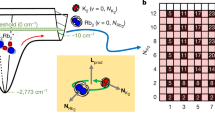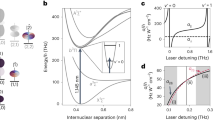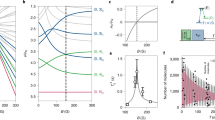Abstract
Quantum-state control of reactive systems has enabled microscopic probes of underlying interaction potentials and the alteration of reaction rates using quantum statistics. However, extending such control to the quantum states of reaction outcomes remains challenging. Here, we realize this goal by utilizing the conservation of nuclear spins throughout the reaction. Using resonance-enhanced multiphoton ionization spectroscopy to investigate the products formed in bimolecular reactions between ultracold KRb molecules we find that the system retains a near-perfect memory of the reactants’ nuclear spins, manifested as a strong parity preference for the rotational states of the products. We leverage this effect to alter the occupation of these product states by changing the coherent superposition of initial nuclear spin states with an external magnetic field. In this way, we are able to control both the inputs and outputs of a reaction with quantum-state resolution. The techniques demonstrated here open up the possibilities to study quantum entanglement between reaction products and ultracold reaction dynamics at the state-to-state level.

This is a preview of subscription content, access via your institution
Access options
Access Nature and 54 other Nature Portfolio journals
Get Nature+, our best-value online-access subscription
$29.99 / 30 days
cancel any time
Subscribe to this journal
Receive 12 print issues and online access
$259.00 per year
only $21.58 per issue
Buy this article
- Purchase on Springer Link
- Instant access to full article PDF
Prices may be subject to local taxes which are calculated during checkout




Similar content being viewed by others
Data availability
The data that support the findings of this study are available in Harvard Dataverse with the identifier https://doi.org/10.7910/DVN/VGHISE. Source data are provided with this paper.
Code availability
The computer code used to analyse the data is available from the corresponding authors upon reasonable request.
References
Chang, Y.-P., Horke, D. A., Trippel, S. & Küpper, J. Spatially-controlled complex molecules and their applications. Int. Rev. Phys. Chem. 34, 557–590 (2015).
Vitanov, N. V., Rangelov, A. A., Shore, B. W. & Bergmann, K. Stimulated raman adiabatic passage in physics, chemistry, and beyond. Rev. Mod. Phys. 89, 015006 (2017).
Shapiro, M. & Brumer, P. Coherent control of molecular dynamics. Rep. Prog. Phys. 66, 224302 (2003).
Lin, J. J., Zhou, J., Shiu, W. & Liu, K. State-specific correlation of coincident product pairs in the F + CD4 reaction. Science 300, 966–969 (2003).
Ashfold, M. N. et al. Imaging the dynamics of gas phase reactions. Phys. Chem. Chem. Phys. 8, 26–53 (2006).
Yang, X. State-to-state dynamics of elementary bimolecular reactions. Annu. Rev. Phys. Chem. 58, 433–459 (2007).
Balakrishnan, N. Perspective: Ultracold molecules and the dawn of cold controlled chemistry. J. Chem. Phys. 145, 150901 (2016).
Toscano, J., Lewandowski, H. & Heazlewood, B. R. Cold and controlled chemical reaction dynamics. Phys. Chem. Chem. Phys. 22, 9180–9194 (2020).
Quéméner, G. & Julienne, P. S. Ultracold molecules under control! Chem. Rev. 112, 4949–5011 (2012).
Jankunas, J. & Osterwalder, A. Cold and controlled molecular beams: production and applications. Annu. Rev. Phys. Chem. 66, 241–262 (2015).
Klein, A. et al. Directly probing anisotropy in atom–molecule collisions through quantum scattering resonances. Nat. Phys. 13, 35–38 (2017).
de Jongh, T. et al. Imaging the onset of the resonance regime in low-energy NO-He collisions. Science 368, 626–630 (2020).
Gordon, S. D. et al. Quantum-state-controlled channel branching in cold Ne(3P2)+Ar chemi-ionization. Nat. Chem. 10, 1190–1195 (2018).
Puri, P. et al. Synthesis of mixed hypermetallic oxide BaOCa+ from laser-cooled reagents in an atom-ion hybrid trap. Science 357, 1370–1375 (2017).
Ospelkaus, S. et al. Quantum-state controlled chemical reactions of ultracold potassium-rubidium molecules. Science 327, 853–857 (2010).
Ni, K.-K. et al. Dipolar collisions of polar molecules in the quantum regime. Nature 464, 1324–1328 (2010).
Hall, F. H. & Willitsch, S. Millikelvin reactive collisions between sympathetically cooled molecular ions and laser-cooled atoms in an ion-atom hybrid trap. Phys. Rev. Lett. 109, 233202 (2012).
Perreault, W. E., Mukherjee, N. & Zare, R. N. Quantum control of molecular collisions at 1 kelvin. Science 358, 356–359 (2017).
Guo, M. et al. Dipolar collisions of ultracold ground-state bosonic molecules. Phys. Rev. X 8, 041044 (2018).
Kilaj, A. et al. Observation of different reactivities of para and ortho-water towards trapped diazenylium ions. Nat. Commun. 9, 2096 (2018).
Bohn, J. L., Rey, A. M. & Ye, J. Cold molecules: Progress in quantum engineering of chemistry and quantum matter. Science 357, 1002–1010 (2017).
Brumer, P., Bergmann, K. & Shapiro, M. Identical collision partners in the coherent control of bimolecular reactions. J. Chem. Phys. 113, 2053–2055 (2000).
Gong, J., Shapiro, M. & Brumer, P. Entanglement-assisted coherent control in nonreactive diatom–diatom scattering. J. Chem. Phys. 118, 2626–2636 (2003).
Brif, C., Chakrabarti, R. & Rabitz, H. Control of quantum phenomena: past, present and future. New J. Phys. 12, 075008 (2010).
Crim, F. F. Bond-selected chemistry: vibrational state control of photodissociation and bimolecular reaction. J. Phys. Chem. 100, 12725–12734 (1996).
Hundt, P. M., Jiang, B., van Reijzen, M. E., Guo, H. & Beck, R. D. Vibrationally promoted dissociation of water on Ni (111). Science 344, 504–507 (2014).
Bell, M. T. & P. Softley, T. Ultracold molecules and ultracold chemistry. Mol. Phys. 107, 99–132 (2009).
Levine, R. D. Molecular Reaction Dynamics (Cambridge Univ. Press, 2009).
Quack, M. Detailed symmetry selection rules for reactive collisions. Mol. Phys. 34, 477–504 (1977).
Oka, T. Nuclear spin selection rules in chemical reactions by angular momentum algebra. J. Mol. Spectrosc. 228, 635–639 (2004).
Uy, D., Cordonnier, M. & Oka, T. Observation of ortho-para \({{\mathrm{H}}_3}^{+}\) selection rules in plasma chemistry. Phys. Rev. Lett. 78, 3844 (1997).
Cordonnier, M. et al. Selection rules for nuclear spin modifications in ion-neutral reactions involving \({{\mathrm{H}}_3}^{+}\). J. Chem. Phys. 113, 3181–3193 (2000).
Fushitani, M. & Momose, T. Nuclear spin selection rule in the photochemical reaction of CH3 in solid parahydrogen. J. Chem. Phys. 116, 10739–10743 (2002).
Momose, T., Fushitani, M. & Hoshina, H. Chemical reactions in quantum crystals. Int. Rev. Phys. Chem. 24, 533–552 (2005).
Schramm, B., Bamford, D. & Moore, C. B. Nuclear spin state conservation in photodissociation of formaldehyde. Chem. Phys. Lett. 98, 305–309 (1983).
Webb, A. D., Dixon, R. N. & Ashfold, M. N. Imaging studies of the photodissociation of H2S+ cations. I. Illustrations of the role of nuclear spin. J. Chem. Phys. 127, 224307 (2007).
Mayle, M., Quéméner, G., Ruzic, B. P. & Bohn, J. L. Scattering of ultracold molecules in the highly resonant regime. Phys. Rev. A 87, 012709 (2013).
Christianen, A., Karman, T. & Groenenboom, G. C. A quasiclassical method for calculating the density of states of ultracold collision complexes. Phys. Rev. A 100, 032708 (2019).
Liu, Y. et al. Photo-excitation of long-lived transient intermediates in ultracold reactions. Nat. Phys. 16, 1132–1136 (2020).
Atkins, P. W. & Friedman, R. S. Molecular Quantum Mechanics (Oxford Univ. Press, 2011).
Liu, Y., Grimes, D. D., Hu, M.-G. & Ni, K.-K. Probing ultracold chemistry using ion spectrometry. Phys. Chem. Chem. Phys. 22, 4861–4874 (2020).
Ospelkaus, S. et al. Controlling the hyperfine state of rovibronic ground-state polar molecules. Phys. Rev. Lett. 104, 030402 (2010).
Aldegunde, J., Rivington, B. A., Żuchowski, P. S. & Hutson, J. M. Hyperfine energy levels of alkali-metal dimers: Ground-state polar molecules in electric and magnetic fields. Phys. Rev. A 78, 033434 (2008).
Hu, M.-G. et al. Direct observation of bimolecular reactions of ultracold KRb molecules. Science 366, 1111–1115 (2019).
Seto, J. Y., Le Roy, R. J., Verges, J. & Amiot, C. Direct potential fit analysis of the \({X}^{1}{\Sigma }_{g}^{+}\) state of Rb2: Nothing else will do! J. Chem. Phys. 113, 3067–3076 (2000).
Falke, S., Sherstov, I., Tiemann, E. & Lisdat, C. The \({A}^{1}{\Sigma }_{u}^{+}\) state of K2 up to the dissociation limit. J. Chem. Phys. 125, 224303 (2006).
Aikawa, K. et al. Coherent transfer of photoassociated molecules into the rovibrational ground state. Phys. Rev. Lett. 105, 203001 (2010).
Banerjee, J. et al. Direct photoassociative formation of ultracold KRb molecules in the lowest vibrational levels of the electronic ground state. Phys. Rev. A 86, 053428 (2012).
Nesbitt, D. J. Toward state-to-state dynamics in ultracold collisions: Lessons from high-resolution spectroscopy of weakly bound molecular complexes. Chem. Rev. 112, 5062–5072 (2012).
González-Martínez, M. L., Dulieu, O., Larrégaray, P. & Bonnet, L. Statistical product distributions for ultracold reactions in external fields. Phys. Rev. A 90, 052716 (2014).
Park, J. W., Yan, Z. Z., Loh, H., Will, S. A. & Zwierlein, M. W. Second-scale nuclear spin coherence time of ultracold 23Na40K molecules. Science 357, 372–375 (2017).
Gunthardt, C. E., Aardema, M. N., Hall, G. E. & North, S. W. Evidence for lambda doublet propensity in the UV photodissociation of ozone. J. Chem. Phys. 151, 224302 (2019).
Lique, F., Honvault, P. & Faure, A. Ortho–para-H2 conversion processes in astrophysical media. Int. Rev. Phys. Chem. 33, 125–149 (2014).
Li, J. & Kais, S. Entanglement classifier in chemical reactions. Sci. Adv. 5, eaax5283 (2019).
Bernath, P. F. Spectra of Atoms and Molecules (Oxford Univ. Press, 2016).
Lemont, S., Giniger, R. & Flynn, G. Radiative lifetime and quenching cross section of the B1Πu state of K2 by time correlated single photon counting using a mode-locked He–Ne laser. J. Chem. Phys. 66, 4509–4515 (1977).
Engelke, F., Hage, H. & Schühle, U. The K2 \({B}^{1}{\Pi }_{u}-{X}^{1}{\Sigma }_{g}^{+}\) band system. Crossed laser-molecular-beam spectroscopy using doppler-free two-photon ionization. Chem. Phys. Lett. 106, 535–539 (1984).
Caldwell, C., Engelke, F. & Hage, H. High resolution spectroscopy in supersonic nozzle beams: The Rb2 \({B}^{1}{\Pi }_{u}-{X}^{1}{\Sigma }_{g}^{+}\) band system. Chem. Phys. 54, 21–31 (1980).
Amiot, C. & Vergès, J. Optical-optical double resonance and Fourier transform spectroscopy: The Rb2 \({B}^{1}{\Pi }_{u}\) electronic state up to the quasibound energy levels. Chem. Phys. Lett. 274, 91–98 (1997).
Brown, J. M. & Carrington, A. Rotational Spectroscopy of Diatomic Molecules (Cambridge Univ. Press, 2003).
Neyenhuis, B. et al. Anisotropic polarizability of ultracold polar 40K87Rb molecules. Phys. Rev. Lett. 109, 230403 (2012).
Ni, K.-K.A. Quantum Gas of Polar Molecules. PhD thesis, Univ. Colorado Boulder (2009).
Yang, D. et al. A global full-dimensional potential energy surface for the K2Rb2 complex and its lifetime. J. Phys. Chem. Lett. 11, 2605–2610 (2020).
Byrd, J. N., Montgomery, J. A. Jr. & Côté, R. Structure and thermochemistry of K2Rb, KRb2, and K2Rb2. Phys. Rev. A 82, 010502 (2010).
Acknowledgements
We thank T. Rosenband for providing the code used to calculate the molecular hyperfine structure, J. Bohn for discussions, R. Vexiau for calculations of relevant molecular transitions and N. Hutzler and H. Guo for critical reading of the manuscript. This work is supported by the DOE Young Investigator Program, the David and Lucile Packard Foundation and the NSF through the Harvard-MIT CUA. M.A.N. is supported by a HQI fellowship. G.Q. acknowledges funding from the FEW2MANY-SHIELD Project No. ANR-17-CE30-0015 from Agence Nationale de la Recherche.
Author information
Authors and Affiliations
Contributions
M.-G.H., Y.L., M.A.N., L.Z. and K.-K.N. carried out the experimental work and data analysis. M.-G.H., G.Q. and O.D. performed the theoretical work. All authors contributed to interpreting the results and writing the manuscript.
Corresponding authors
Ethics declarations
Competing interests
The authors declare no competing interests.
Additional information
Peer review information Nature Chemistry thanks the anonymous reviewers for their contribution to the peer review of this work.
Publisher’s note Springer Nature remains neutral with regard to jurisdictional claims in published maps and institutional affiliations.
Extended data
Extended Data Fig. 1 The optical setup for generating the REMPI beams.
The 648/674 nm and 532 nm lasers are combined on a dichroic mirror, and are then sent through a dark mask (Thorlabs R1DF100) and an achromatic lens (focal length = 300 mm). The resulting beam profiles in the image plane have a 1 mm outer diameter and a 100 μm inner diameter.
Extended Data Fig. 2 REMPI spectrum for 40K2 product molecules at 30 G.
By scanning the 648 nm laser frequency to search for rotational lines within the \({X}^{1}\mathop{\sum }\nolimits_{g}^{+}\left(v=0,{N}_{{{\rm{K}}}_{2}}\right)\ \to \ {B}^{1}{\prod }_{u}\left({v}^{\prime}=1,{N}_{{{\rm{K}}}_{2}}^{\prime }\right)\) vibronic band, we observe strong \({{\mathrm{K}}_{2}}^{+}\) signals at frequencies corresponding to rotational states with even values of \({N}_{{{\rm{K}}}_{2}}\) (red filled circles), and highly suppressed signals for odd values (black open circles). The ion count for each data point is normalized by the corresponding number of experimental cycles (~ 16); the error bars denote shot noise. For \({N}_{{{\rm{K}}}_{2}}>0\), we drive transitions with \({N}_{{{\rm{K}}}_{2}}^{\prime }-{N}_{{{\rm{K}}}_{2}}=0\) (Q branch), whereas for \({N}_{{{\rm{K}}}_{2}}=0\), we drive the only allowed transition, with \({N}_{{{\rm{K}}}_{2}}^{\prime }-{N}_{{{\rm{K}}}_{2}}=1\) (R branch). Blue dashed lines indicate the predicted transition frequencies. We do not observe any signals at frequencies corresponding to states with \({N}_{{{\rm{K}}}_{2}}>12\). Gaussian fits (black curves) are applied to each signal peak, yielding a typical spectral linewidth (1σ) of ~ 50 MHz.
Extended Data Fig. 3 REMPI spectrum for 87Rb2 product molecules at 30 G.
The frequency of the 674 nm laser is scanned within the \({X}^{1}\mathop{\sum }\nolimits_{g}^{+}(v=0,{N}_{{{\rm{Rb}}}_{2}})\ \to \ {B}^{1}{\prod }_{u}({v}^{\prime}=4,{N}_{{{\rm{Rb}}}_{2}}^{\prime })\) vibronic band. We observe strong \({{\mathrm{Rb}}_{2}}^{+}\) signals for transitions from odd rotational states (blue filled circles), and highly suppressed signals from even ones (black open circles). The ion count for each data point is normalized by the corresponding number of experimental cycles (~ 16); the error bars denote shot noise. We drive Q branch transitions for \({N}_{{{\rm{Rb}}}_{2}}>0\), and R branch for \({N}_{{{\rm{Rb}}}_{2}}=0\). Blue dashed lines indicate the predicted transition frequencies. We do not observe any signals at frequencies corresponding to states with \({N}_{{{\rm{Rb}}}_{2}}>19\). Gaussian fits (black curves) are applied to each signal peak, yielding a typical spectral linewidth (1σ) of ~ 40 MHz.
Extended Data Fig. 4 REMPI spectrum for 87Rb2 product molecules at 5 G.
The frequency of the 674 nm laser is scanned within the \({X}^{1}\mathop{\sum }\nolimits_{g}^{+}(v=0,{N}_{{{\rm{Rb}}}_{2}})\ \to \ {B}^{1}{\prod }_{u}({v}^{\prime}=6,{N}_{{{\rm{Rb}}}_{2}}^{\prime })\) vibronic band. We observe strong \({{\mathrm{Rb}}_{2}}^{+}\) signals for transitions from both even (red filled circles) and odd (blue filled circles) rotational states. The ion count for each data point is normalized by the corresponding number of experimental cycles (~ 20); the error bars denote shot noise. We drive Q branch transitions for \({N}_{{{\rm{Rb}}}_{2}}>0\), and R branch for \({N}_{{{\rm{Rb}}}_{2}}=0\). Blue dashed lines indicate the predicted transition frequencies. We do not observe any signals at frequencies corresponding to states with \({N}_{{{\rm{Rb}}}_{2}}>20\). Gaussian fits (black curves) are applied to each signal peak, yielding a typical spectral linewidth (1σ) of ~ 40 MHz.
Source data
Source Data Fig. 2
Product State Distribution Source Data of \({{\mathrm{K}}_{2}}^{+}\)
Source Data Fig. 3
Product State Distribution Source Data of \({{\mathrm{Rb}}_{2}}^{+}\)
Source Data Fig. 4
B Field Control Source Data
Source Data Extended Data Fig. 2
REMPI Spectrum Source Data of \({{\mathrm{K}}_{2}}^{+}\) at 30 G
Source Data Extended Data Fig. 3
REMPI Spectrum Source Data of \({{\mathrm{Rb}}_{2}}^{+}\) at 30 G
Source Data Extended Data Fig. 4
REMPI Spectrum Source Data of \({{\mathrm{Rb}}_{2}}^{+}\) at 5 G
Rights and permissions
About this article
Cite this article
Hu, MG., Liu, Y., Nichols, M.A. et al. Nuclear spin conservation enables state-to-state control of ultracold molecular reactions. Nat. Chem. 13, 435–440 (2021). https://doi.org/10.1038/s41557-020-00610-0
Received:
Accepted:
Published:
Issue Date:
DOI: https://doi.org/10.1038/s41557-020-00610-0
This article is cited by
-
Robust storage qubits in ultracold polar molecules
Nature Physics (2021)
-
Precision test of statistical dynamics with state-to-state ultracold chemistry
Nature (2021)
-
Ultimate control in chemistry
Nature Chemistry (2021)



